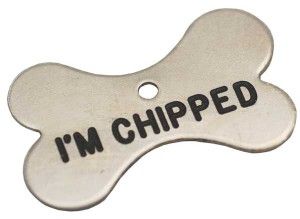By Jim Tedford, Director of Animal Affairs and Alliances
Many years ago, a friend and colleague in animal welfare shared with me information on a promotional campaign encouraging pet owners to put identification on their pets. I don’t recall all the details, but I do remember that one of the key phrases in the campaign said something to the effect of “When you send your child to summer camp, you put your name on his underwear. Why not put identification on your best friend?”
The idea that we make sure we put ID on everything from our luggage to our bicycles indicates that we plan carefully so as not to lose those things we hold dear. Yet, relatively few people put any sort of ID on their pets. And, all too often, even when a pet does wear a tag (or carry an implanted microchip), the information is not kept up-to-date and is untraceable.
Giving your pets an id tag is an important task, but it is one many pet owners ignore. No one wants to think about losing their pet, but it's always good to have an id just in case!
 When it comes to identification, dog owners are a bit superior to cat owners. During my years as CEO of various sheltering facilities, I recall very few instances of cats showing up with any form of ID. In fact, at my last shelter, I decreed we would call a news conference the next time a cat arrived bearing any sort of ID. It never happened.
When it comes to identification, dog owners are a bit superior to cat owners. During my years as CEO of various sheltering facilities, I recall very few instances of cats showing up with any form of ID. In fact, at my last shelter, I decreed we would call a news conference the next time a cat arrived bearing any sort of ID. It never happened.
Lest you dog owners start to gloat, you aren’t THAT superior. The frustration of finding a dog with an obvious owner is repeated daily in the sheltering world. They show up well-fed, apparently healthy, sometimes wearing expensive collars – but with no ID tags or microchips. Shelters often find themselves in the position of having no choice but to sit and wait…and hope. So, what can you do? This one is so simple.
1. Put a rabies vaccination tag (sequentially numbered and easily traceable) and an ID tag that contains your CURRENT contact information on your pets’ collars.
This applies to dogs and cats alike. ID tags are available from all major pet retailers – in fact, many have automated engravers which are pretty cool to operate. If you don’t have access to a store, there are plenty of websites where tags can be purchased. They come in all sorts of sizes, shapes and colors to suit your pet’s individual tastes.
2. Consider having your pet implanted with an identifying microchip.
While a bit pricier than a tag, chips are not easily removed and are considered an effective permanent form of identification. It would be wise to poll veterinarians and animal shelters in your area to determine which type/brand of microchip they recommend. While there are universal scanners that detect various types of chips, many vets and shelters have scanners designed specifically to read the types of chips they sell. So, you will want to implant the chip most common to your area.
Jim with Bodie and Sam - you can be sure these dogs have proper identification. Jim wouldn't know what to do without them so he isn't taking any chances.
 If cost is a major concern, you can simply use a permanent marker to write your telephone number directly on your pet’s collar. Print large enough that the number can be easily spotted and read. And, keep an eye on it for fading. Regardless of the identification method(s) you choose, do not forget to keep your information updated.
If cost is a major concern, you can simply use a permanent marker to write your telephone number directly on your pet’s collar. Print large enough that the number can be easily spotted and read. And, keep an eye on it for fading. Regardless of the identification method(s) you choose, do not forget to keep your information updated.
When you change your address with the post office, change your pet’s ID information, as well. Nobody wants to think of losing our pets, but it happens to the best of us. I have been around hundreds of thousands of dogs in my lifetime and have never run across one who can tell me his name or phone number or address. If your best friend is at least as important to you as your child’s underwear, make sure he wears every form of identification you can get. It might just be his ticket home.
ABOUT JIM Jim Tedford serves as PetSafe’s Director of Animal Affairs and Alliances. Working on the front line of animal welfare for over 20 years, Jim has served as CEO for organizations in New York, Louisiana and Tennessee. Prior to joining PetSafe, Jim provided marketing and fundraising services to animal welfare organizations nationwide. Jim holds a degree in animal science from the University of Tennessee at Knoxville. Jim and his wife Ann share their “empty nest” in the Smoky Mountains with adopted dogs Bodie, Sam, and Lila and a formerly homeless macaw, Gipper.


